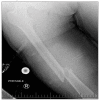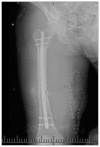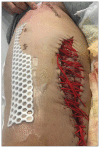Intermittent use of resuscitative endovascular balloon occlusion of the aorta in penetrating gunshot wound of the lower extremity
- PMID: 31782649
- PMCID: PMC6877395
- DOI: 10.1503/cjs.017018
Intermittent use of resuscitative endovascular balloon occlusion of the aorta in penetrating gunshot wound of the lower extremity
Abstract
The use of resuscitative endovascular balloon occlusion of the aorta (REBOA) in penetrating injuries is an emerging adjunct in the civilian trauma surgeon’s toolbox for the management of traumatic hemorrhagic shock. Furthermore, within the Canadian civilian context, little has been reported with regard to its use as an assisted damage-control measure in vascular reconstruction of the lower extremity. We report a case of penetrating gunshot injury of the lower extremity where the preoperative deployment of REBOA had a remarkable positive impact in the resuscitation phase and the intraoperative control of blood loss. A description of the procedure and the advantage gained from REBOA are discussed.
© 2019 Joule Inc. or its licensors
Conflict of interest statement
D. Deckelbaum and A. Beckett are CJS associate editors. They were not involved in the review of this manuscript or in the decision to accept it for publication. No other competing interests declared.
Figures




References
-
- Meizoso JP, Ray JJ, Karcutskie CA, 4th, et al. Effect of time to operation on mortality for hypotensive patients with gunshot wounds to the torso: The golden 10 minutes. J Trauma Acute Care Surg. 2016;81:685–91. - PubMed
-
- Hughes CW. Use of an intra-aortic balloon catheter tamponade for controlling intra-abdominal hemorrhage in man. Surgery. 1954;36:65–8. - PubMed
-
- Gupta BK, Khaneja SC, Flores L, et al. The role of intra-aortic balloon occlusion in penetrating abdominal trauma. J Trauma. 1989;29:861–5. - PubMed
-
- Branco BC, DuBose JJ. Endovascular solutions for the management of penetrating trauma: an update on REBOA and axillo-subclavien injuries. Eur J Trauma Emerg Surg. 2016;42:687–69. - PubMed
Publication types
MeSH terms
LinkOut - more resources
Full Text Sources
